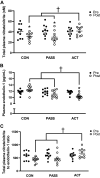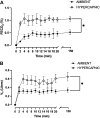Effects of passive and active leg movements to interrupt sitting in mild hypercapnia on cardiovascular function in healthy adults
- PMID: 35175102
- PMCID: PMC8934680
- DOI: 10.1152/japplphysiol.00799.2021
Effects of passive and active leg movements to interrupt sitting in mild hypercapnia on cardiovascular function in healthy adults
Abstract
Prolonged sitting in a mild hypercapnic environment impairs peripheral vascular function. The effects of sitting interruptions using passive or active skeletal muscle contractions are still unclear. Therefore, we sought to examine the vascular effects of brief periods (2 min every half hour) of passive and active lower limb movement to interrupt prolonged sitting with mild hypercapnia in adults. Fourteen healthy adults (24 ± 2 yr) participated in three experimental visits sitting for 2.5 h in a mild hypercapnic environment (CO2 = 1,500 ppm): control (CON, no limb movement), passive lower limb movement (PASS), and active lower limb movement (ACT) during sitting. At all visits, brachial and popliteal artery flow-mediated dilation (FMD), microvascular function, plasmatic levels of nitrate/nitrite and endothelin-1, and heart rate variability were assessed before and after sitting. Brachial and popliteal artery FMDs were reduced in CON and PASS (P < 0.05) but were preserved (P > 0.05) in ACT. Microvascular function was blunted in CON (P < 0.05) but was preserved in PASS and ACT (P > 0.05). In addition, total plasma nitrate/nitrite was preserved in ACT (P > 0.05) but was reduced in CON and PASS (P < 0.05), and endothelin-1 levels were decreased in ACT (P < 0.05). Both passive and active movement induced a greater ratio between the low-frequency and high-frequency bands for heart rate variability (P < 0.05). For the first time, to our knowledge, we found that brief periods of passive leg movement can preserve microvascular function, but that an intervention that elicits larger increases in shear rate, such as low-intensity exercise, is required to fully protect both macrovascular and microvascular function and circulating vasoactive substance balance.NEW & NOTEWORTHY Passive leg movement could not preserve macrovascular endothelial function, whereas active leg movement could protect endothelial function. Attenuated microvascular function can be salvaged by passive movement and active movement. Preservation of macrovascular hemodynamics and plasma total nitrate/nitrite and endothelin-1 during prolonged sitting requires active movement. These findings dissociate the impacts induced by mechanical stress (passive movement) from the change in metabolism (active movement) on the vasculature during prolonged sitting in a mild hypercapnic environment.
Keywords: autonomic function; endothelial function; mechanoreflex; metaboreflex; microvascular function.
Conflict of interest statement
No conflicts of interest, financial or otherwise, are declared by the authors.
Figures






Similar articles
-
Impacts of prolonged sitting with mild hypercapnia on vascular and autonomic function in healthy recreationally active adults.Am J Physiol Heart Circ Physiol. 2020 Aug 1;319(2):H468-H480. doi: 10.1152/ajpheart.00354.2020. Epub 2020 Jul 10. Am J Physiol Heart Circ Physiol. 2020. PMID: 32648821 Free PMC article.
-
Brief periods of inactivity reduce leg microvascular, but not macrovascular, function in healthy young men.Exp Physiol. 2018 Oct;103(10):1425-1434. doi: 10.1113/EP086918. Epub 2018 Aug 15. Exp Physiol. 2018. PMID: 30110509
-
Impact of prolonged sitting on lower and upper limb micro- and macrovascular dilator function.Exp Physiol. 2015 Jul 1;100(7):829-38. doi: 10.1113/EP085238. Epub 2015 Jun 10. Exp Physiol. 2015. PMID: 25929229 Free PMC article.
-
The Acute Effects of Prolonged Uninterrupted Sitting on Vascular Function: A Systematic Review and Meta-analysis.Med Sci Sports Exerc. 2022 Jan 1;54(1):67-76. doi: 10.1249/MSS.0000000000002763. Med Sci Sports Exerc. 2022. PMID: 34334722
-
The Effects of Acute Exposure to Prolonged Sitting, With and Without Interruption, on Vascular Function Among Adults: A Meta-analysis.Sports Med. 2020 Nov;50(11):1929-1942. doi: 10.1007/s40279-020-01325-5. Sports Med. 2020. PMID: 32757163 Review.
Cited by
-
Attenuated reactive hyperemia after prolonged sitting is associated with reduced local skeletal muscle metabolism: insight from artificial intelligence.Am J Physiol Regul Integr Comp Physiol. 2023 Oct 1;325(4):R380-R388. doi: 10.1152/ajpregu.00067.2023. Epub 2023 Jul 17. Am J Physiol Regul Integr Comp Physiol. 2023. PMID: 37458376 Free PMC article.
-
Prolonged sitting is not associated with altered shear-mediated dilation of the internal carotid artery, despite impairing lower limb endothelial function.Physiol Rep. 2025 Feb;13(3):e70097. doi: 10.14814/phy2.70097. Physiol Rep. 2025. PMID: 39878625 Free PMC article.
-
Leg fidgeting alleviates reduced oxygen extraction in the gastrocnemius muscle caused by prolonged sitting: a randomized crossover trial.Eur J Appl Physiol. 2025 Feb;125(2):469-481. doi: 10.1007/s00421-024-05613-0. Epub 2024 Sep 23. Eur J Appl Physiol. 2025. PMID: 39312008 Clinical Trial.
-
Prolonged sitting and peripheral vascular function: potential mechanisms and methodological considerations.J Appl Physiol (1985). 2023 Apr 1;134(4):810-822. doi: 10.1152/japplphysiol.00730.2022. Epub 2023 Feb 16. J Appl Physiol (1985). 2023. PMID: 36794688 Free PMC article. Review.
-
Physiology of sedentary behavior.Physiol Rev. 2023 Oct 1;103(4):2561-2622. doi: 10.1152/physrev.00022.2022. Epub 2023 Jun 16. Physiol Rev. 2023. PMID: 37326297 Free PMC article. Review.
References
-
- Chomistek AK, Manson JE, Stefanick ML, Lu B, Sands-Lincoln M, Going SB, Garcia L, Allison MA, Sims ST, LaMonte MJ, Johnson KC, Eaton CB. Relationship of sedentary behavior and physical activity to incident cardiovascular disease. J Am Coll Cardiol 61: 2346–2354, 2013. doi:10.1016/j.jacc.2013.03.031. - DOI - PMC - PubMed
Publication types
MeSH terms
Associated data
Grants and funding
LinkOut - more resources
Full Text Sources
Medical

